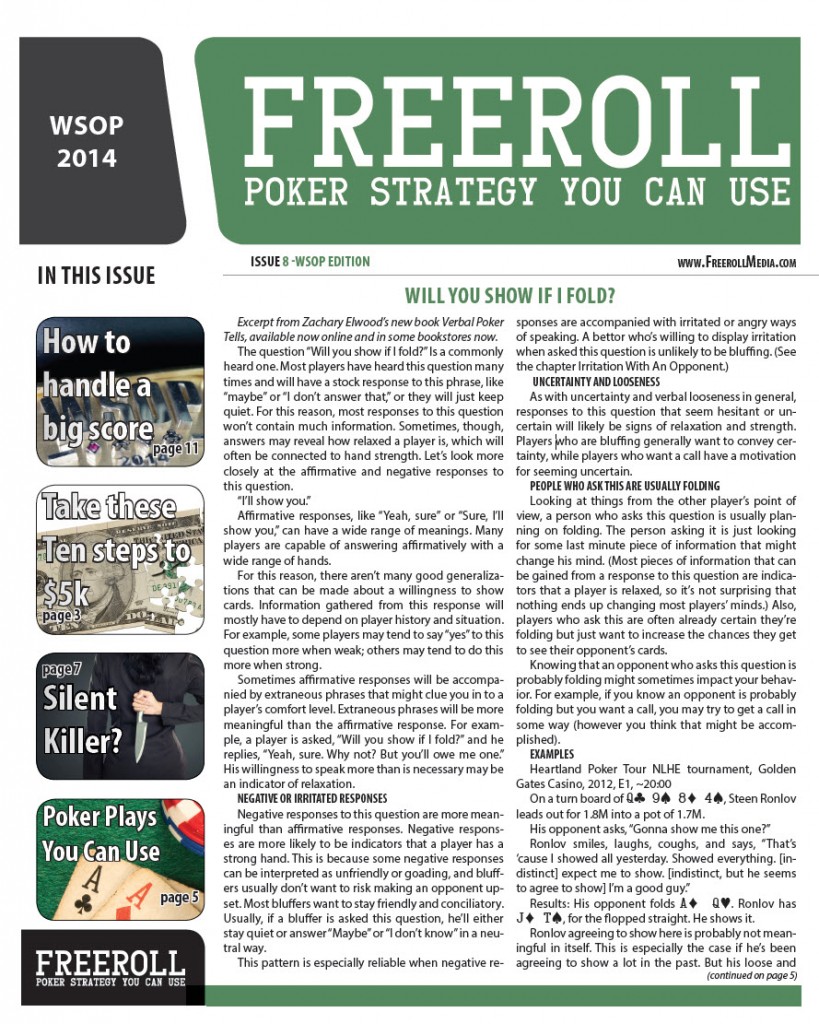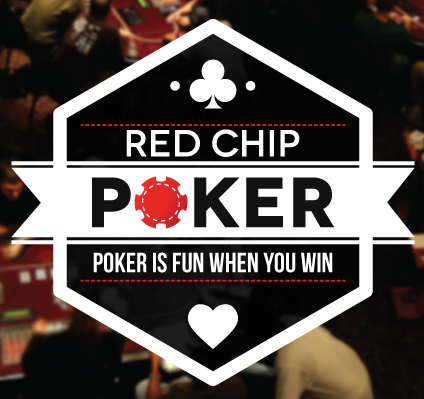Don’t Play No-Limit Hold’em Like It’s A Slot Machine
- By Ed Miller
- December 20, 2013
- Comments Off on Don’t Play No-Limit Hold’em Like It’s A Slot Machine
 You put your money in, press a button, and it deals you a hand. You choose cards to discard, hit another button, and it deals you replacement cards. Then it checks what hand you made and pays you accordingly. Six coins for a flush. Four for a straight. Nine for a full house. Make quads, and you get twenty-five coins. [Apologies to my friend Bob Dancer for calling a video poker machine a “slot.” Bob has carved out a career for himself playing video poker professionally. He’s also created a lot of video poker educational materials, and he teaches classes on the game. If video poker interests you, look him up.]
You put your money in, press a button, and it deals you a hand. You choose cards to discard, hit another button, and it deals you replacement cards. Then it checks what hand you made and pays you accordingly. Six coins for a flush. Four for a straight. Nine for a full house. Make quads, and you get twenty-five coins. [Apologies to my friend Bob Dancer for calling a video poker machine a “slot.” Bob has carved out a career for himself playing video poker professionally. He’s also created a lot of video poker educational materials, and he teaches classes on the game. If video poker interests you, look him up.]
The payouts are fixed. Make the hand, get paid. That’s how it works.
The vast majority of no-limit hold’em players play poker like they’re playing a slot machine. They’re trying to make big hands. That’s foremost in their thought process. Let’s flop a set. Let’s make a flush. Low straights are sneaky. Let’s try to make one of those.
Sometimes when I take on new students, I sit and watch them play for a while. They’ll toss a few chips in with a hand like Kd6d. I’ll ask them why. “What’s your plan for that hand?”
Invariably, the answer involves flop, turn, and river cards that, when combined with a king and six of diamonds, make a rare and very strong poker hand.
It’s nearly universal. Almost everyone who isn’t already a stone cold professional player thinks this way. I’ll get in cheap and see if I can flop something. Let’s make a big hand this time. Stacking people sure is fun. Implied odds, implied odds, implied odds.
Unfortunately, there’s a problem. A big problem.
 Poker is not a slot machine. If you make a flush, you don’t get paid six coins. Sometimes you stack someone. But much more often, you get almost nothing for it. And every once in a while, you’ll run into an even better hand, and you’ll be the one getting stacked.
Poker is not a slot machine. If you make a flush, you don’t get paid six coins. Sometimes you stack someone. But much more often, you get almost nothing for it. And every once in a while, you’ll run into an even better hand, and you’ll be the one getting stacked.
Take these hands, for instance.
Some people limp in, and you limp with 7c4c. The blinds call and check. The flop comes 6-5-3 rainbow. Bingo!
Everyone checks, you bet half the pot, and everyone folds.
Someone raises preflop, and you call with 3-3. The big blind calls. The flop comes 9-4-3 with a flush draw. The big blind checks, and the preflop raiser checks. You bet half pot, and both players fold.
Someone raises preflop. A player calls, and you call with 8h6h. The big blind calls. The flop comes Ah9h2h. Everyone checks to you. You bet half pot, and everyone folds.
Be honest. How many times have you played hands like these? You hit gin on the flop, and you don’t even begin to sniff someone else’s stack. I’ve played these hands a zillion times. It happens all the time.
How about this one. It’s a $2-$5 game with $1,000 stacks. A player opens to $20. Another player calls, and you call with 8h6h. The big blind calls. There’s $82 in the pot with $980 behind.
The flop comes Ah9h2h. Everyone checks to you. You bet $50. The big blind calls, and the other two players fold. There’s $182 in the pot with $930 behind.
The turn is the 3c. The big blind checks. You bet $150, and he check-raises to $420. You call. There’s $1,022 in the pot with $510 behind.
The river is the 4d. He shoves for $510.
How do you like your small flush?
You hate it, right? This is the cue for you to take your sunglasses off and say, “This is soooo sick,” between seven and nine times. Then someone calls clock on you, and you wait it out for 55 seconds, fidgeting nervously with your chips and sunglasses. Finally you end up folding, because ultimately you know as well as everyone else that the guy has the king-high flush.
On a slot machine, you try to make a flush because if you make one you will get paid six coins. In no-limit hold’em, very frequently making a flush doesn’t pay squat.
The Flipside
On the other hand, sometimes making a flush is hugely valuable. Consider this hand. It’s $2-$5 game with $1,000 stacks. You open to $15 from one off the button with Ac4c. The small blind reraises to $55. The big blind folds, and you call. There’s $115 in the pot, and you have $945 behind.
The flop is 8h5c3s. The small blind bets $70. You min-raise to $140, and he calls. There’s $395 in the pot, and you have $805 behind.
The turn is the Tc. The small blind checks, and you bet $270. The small blind calls. There’s $935 in the pot, and you have $535 behind.
The river is the Qc.
You made a flush. I guarantee that the moment you see that river card, you will be mentally fist-pumping as hard as you ever do at a poker table.
This is a flush that matters.
What’s the difference between this hand and the other hands? In this hand, making a flush and winning a huge pot was Plan D. Plan A was to win the pot preflop with a blind steal. When that didn’t work, Plan B was to win the pot on this favorable flop.[If it’s not obvious why this flop is “favorable”, keep reading. This stuff is what the book is about.] When that didn’t work, Plan C was to win the pot on the turn with a fairly massive bet. When that didn’t work, it became fairly clear that the small blind held a big overpair.
It was time for Plan D. Suck out.
If you’re like most no-limit players, you rarely (if ever) play hands like the above. Maybe you fold preflop. Maybe you just call on the flop rather than raise. (Maybe you even fold the flop.) Maybe you raise the flop, but you check it back after you get called when you turn the flush draw.
If you don’t play hands like the above, then you’re doing it all wrong.
Flushes are rare hands. A slot machine pays you a fixed six coin payout every time you make one. It’s a payout that’s finely tuned to compensate you (almost) fairly for the hand’s rarity.
There’s no finely tuned fixed payout in poker. Fishing for flushes on the flop and turn will leave you disappointed. Too often you will end up winning very little for your big hand. The rest of the time, when you miss your hand, you’ll be folding and folding, bleeding money slowly away.
And if you make a small flush and play a massive pot, there’s a good chance you’ll be losing it.
Flushes are much more useful when the pot already happens to be massive when you make one.
The Other Problem
Here’s the other problem. You’re playing to try to make big hands and stack people. Simple enough.
That guy on your left, guess what his plan is. If you guessed that he’s trying to make big hands and stack people, you’re correct. How about that older gentleman in the Yankee’s hat across the table? Yup, trying to make a big hand and stack someone. How about that woman with the headphones on trying to ignore the unhygienic fellow to her right? She’s trying to make a big hand and stack someone.
Once upon a time, you could sit, wait for big hands, and count on some bumbling fool with no kicker to hand you a stack for it. Those days are well gone. When I sit in a randomly-selected $2-$5 game in Las Vegas these days, I’d guess at least seven out of my nine opponents all have the same gameplan. They want to make big hands and stack people while refusing to pay off other players’ big hands.
If everyone else plays with your same strategy, who wins? Not you.
The Bottom Line
As long as you build your strategy around trying to make big hands, you will never be good enough to move up and match wits with the professionals. You will lose to them. Until you abandon the entire thought process and rebuild from scratch, you will never beat them.
Poker is not a slot machine. Stop playing it like one.
This article is an excerpt from Ed’s forthcoming Poker’s 1%. Pre-order it from NotedPokerAuthority.com


